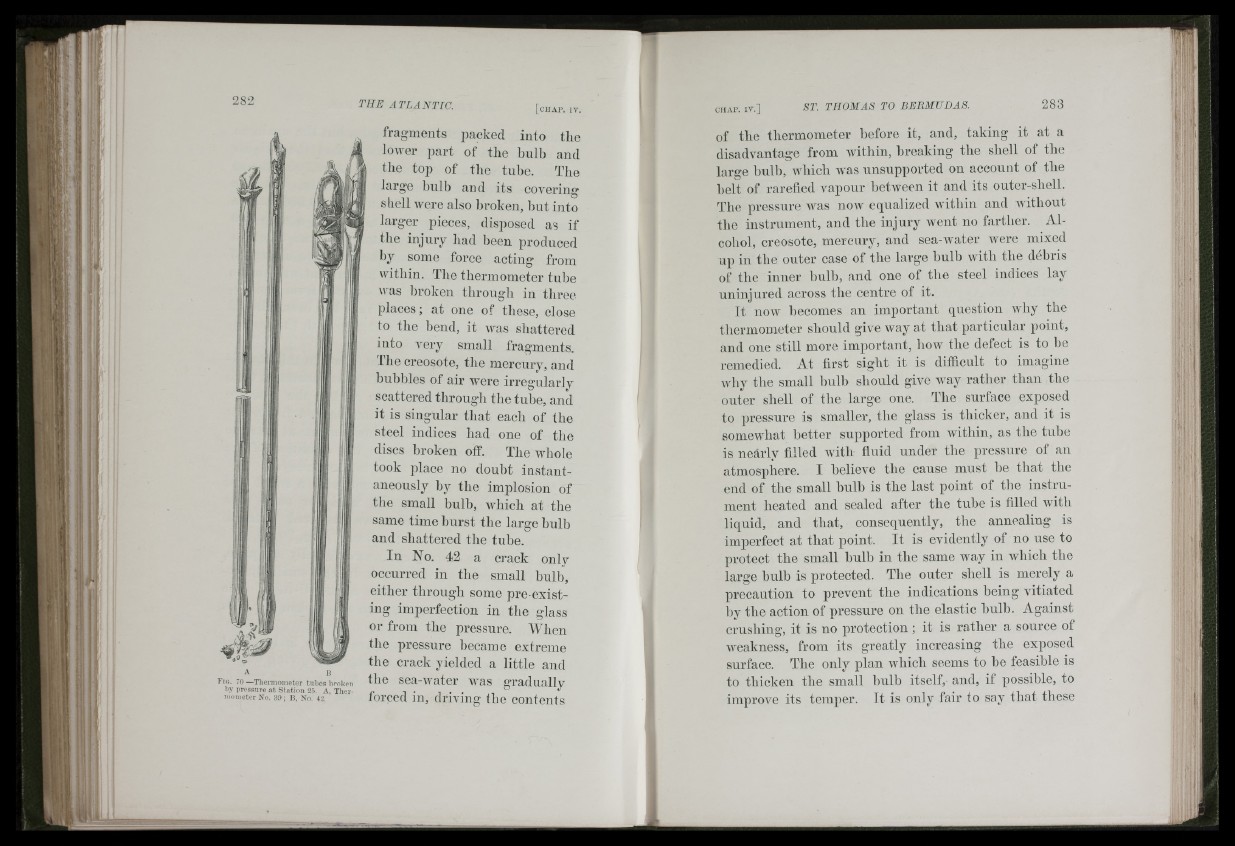
282
I;l
F io . 70 —T iie rm om e te r tu b e s b ro k en
by p re s su re a t S ta tio n 2.5. A. T h e rm
om e te r No. 30 ; B, No. 42
fragments loacked into the
loAver part of tlie bulb and
the top of the tube. The
large Imlb and its covering
shell were also broken, Imt into
larger pieces, disposed as if
the injury had been produced
by some force acting from
within. The thermometer tuhe
was broken through in tliree
places ; at one of these, close
to the bend, it ivas shattered
into very small fragments.
The creosote, the mercury, and
bubbles of air were irregularly
scattered through the tube, and
it is singular that each of the
steel indices had one of the
discs broken off. The whole
took place no douht iastant-
aneously by the implosion of
the small bulb, which at the
same time burst the large bulb
and shattered the tube.
In No. 42 a crack only
occurred in the small bulb,
either through some pre-existing
imperfection in the glass
or from the pressure. When
the pressure became extreme
the crack yielded a little and
the sea-Avater Avas gradually
forced in, driving the contents
o f th e th e rm om e t e r b e fo r e i t , a n d , t a k in g i t a t a
d is a d v a n ta g e fr om Avithin, b r e a k in g th e s h e ll o f th e
la r g e h u lh , AAdiich w a s u n su p p o r t e d o n a c c o u n t o f th e
b e lt o f r a r e fied v a p o u r b e tw e e n i t a n d i t s o u t e r - sh e ll.
T h e p r e s su r e Avas uoav e q u a liz e d w i th in a n d Avithout
th e in s t r u m e n t , a n d th e in ju r y w e n t n o fa r th e r . Alcohol,
c r e o s o te , m e r c u r y , a n d sea-Avater Avere m ix e d
up in th e o u t e r c a s e o f th e la r g e h n lb w ith th e d éb r is
of th e in n e r b u lb , a n d o n e o f t h e s t e e l in d ic e s la y
u n in ju r e d a c r o s s th e c e n t r e o f it .
It noAV becomes an important question why the
thermometer should give way at that particular point,
and one still more important, how the defect is to be
remedied. At first sight it is difficult to imagine
Avhy the small bulb should give Avay rather than the
outer shell of the large one. The surface exposed
to pressure is smaller, the glass is thicker, and it is
somewhat better supported from Avithin, as the tuhe
is nearly filled Avith fluid under the pressure of an
atmosphere. I helieve the cause must be that the
end of the small hulh is the last point of tlie instrument
heated and sealed after the tube is filled Avith
liquid, and that, consequently, the annealing is
imperfect at that point. It is evidently of no use to
protect the small hnlb in the same way in which the
large hnlb is protected. The outer shell is merely a
precaution to prevent the indications heing vitiated
by the action of pressure on the elastic hnlb. Against
crushing, it is no protection; it is rather a source of
weakness, from its greatly increasing the exposed
surface. The only plan which seems to be feasible is
to thicken the small hnlb itself,- and, if possible, to
improve its temper. It is only fair to say that these
Jh' L" '
Ihte.: uf."" r
-'oij-
t"i